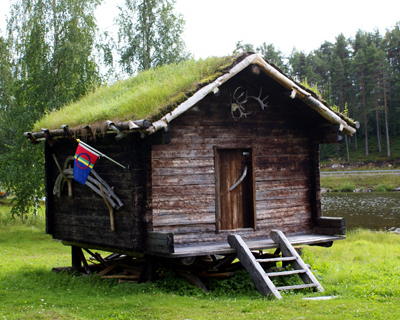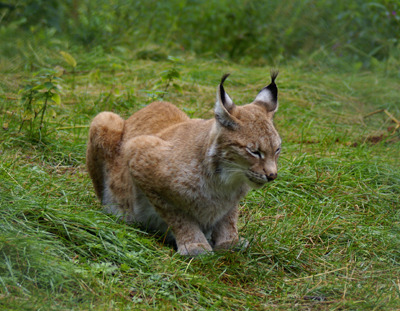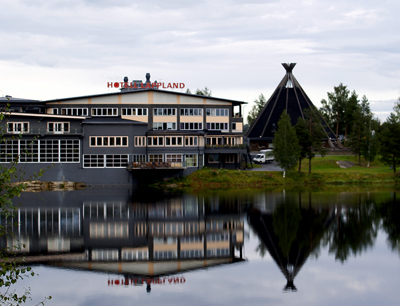What’s a Hembygdsgård Anyway? Posted by Transparent Language on Aug 15, 2008 in Culture
Because there’s not much to say about the Swedish performance at the Olympics (Ara Abrahamian’s hissy fit resulting in his bronze medal being revoked and Carolina Klüft’s dismal results so far, and that’s it in a nutshell) I’m going to continue talking about the wonders of Norrland instead.
But first things first.
Did you know that an open-air museum was a Scandinavian concept? The first one was actually organized in 1881 in Norway, and ten years later, an inspired guy by the name of Artur Hazelius set up the famous Skansen in Stockholm. The rest is history. The word “skansen” became synonymous with an open-air museum, and the idea was copied all over Europe and beyond. And of course, all over Sweden, too. These days almost every town and village of any standing has its very own open-air museum. In English they’re known as “folk museums”, “living history museums”, “museums of buildings”, etc. and generally mean a place full of old buildings where the poor staff is forced to prance around in period costumes.
In Swedish they’re known as “friluftmuseum” or “hembygdsgård”, and believe it or not, there are more than 1 300 of them in this country. That’s one open-air museum for every 7 thousand Swedes (including babies and really old people). See? I tell you, this stuff is big over here. Really big.
Some of them, like Stockholm’s Skansen are truly superb, some are OK, and some need to serve free waffles during summer weekends to get enough visitors. I admit, I’m a totally sucker for open-air museums. I love them all, the dinkier the better. Last year while driving to Kiruna, I made my poor friend stop at every single one along the way. She finally drew the line at an outdoor tractor museum somewhere outside of Luleå, and I still haven’t quite forgiven her for that.
Umeå’s own open-air museum is called Gammlia, and as far as those things go, it’s OK. Some people say that when you’ve seen one hembygdsgård, you’ve seen them all. And there’s some truth in it. So I didn’t really expect much last weekend at Gammplatsen in Lycksele. And I wasn’t disappointed. With a whopping 80SEK (about 8 euro) admission fee, you’d really think they could have done a better job. At least Gammlia in Umeå is free.

One of the Sami buildings at the open-air museum in Lycksele
In Lycksele I really wanted to see Sameviste – an old Sami camp. It was also disappointing. So disappointing in fact, that we promptly left and went to the zoo (zoo = djurpark) instead. Lycksele djurpark, on the other hand, was delightful. It’s the northernmost zoo in Sweden (and quite possibly in the world, further north than Fairbanks, Alaska – just so you know for comparison) and contains only Nordic animals. And it totally rocks! Who needs pandas when you can have baby lynx and the cutest brown bears ever, huh? The zoo was truly excellent.

If that’s not adorable, then I don’t know what is.
Not much else is excellent in Lycksele on a Saturday afternoon. The main street shopping closes at 2PM, and because the only open coffee shop chased us away at 4PM, we had no other option but to investigate the world famous restaurant by the world famous Lappland Hotel. Not sure exactly why the hotel is famous, it’s overpriced and thoroughly average. But if the tourist office says it’s world-famous, then it surely must be true.
The restaurant “Lappkåtan” is something else altogether. And as its name indicates, it’s a huge, giant Sami kåta. The largest in the world measuring 27 meters. Quite impressive actually (even if the food is not).
What’s a kåta? It’s a traditional type of a Sami dwelling, which looks like a teepee, or a wigwam. Same idea, different name. Be careful with that name, though. It’s “kåta”, which is an “en” noun.
“Kåt”, on the other hand, is an adjective and means something totally different – is it OK to say it here on the blog? – “horny”. So, don’t confuse these two, OK?

Build vocabulary, practice pronunciation, and more with Transparent Language Online. Available anytime, anywhere, on any device.





Comments:
Arsh:
Hej Anna!
Wow! Did not know that there are 1300 hembygdsgård in Sweden! Many thanks for another excellent and entertaining cultural blog. I love your blog so much that I even if I have to pay to read it, I will! You mentioned a trip last year to Kiruna..did you sleep in the Ice Hotel? I would love to hear from someone who did about the experience!
On a serious note; are Samis represented in the various political parties in Sweden and in the Swedish parliament?
Ha det bra,
Arsh
ce:
hej anna!!! a very well narration for me! thank you! really, i looked at lycksele s djurpark yet, and i think it woul be a nice place to visit! kids would enjoy it so much…thank anna again! ceci
Anna:
Hej Arsh!
You’re such a flatterer, aren’t you? But thank you so much for your kind words! 🙂
Hmmm… the Ice Hotel… You know, I’ve never been there, it’s sooooo touristy. But we’ll see, I just might have to pay them a visit this coming winter and report back here on the blog! It will be fun! 😉
Anna:
Hej ce!
I can tell you right now, your little ones will LOVE the djurpark! There are many activities for families with kids here – as you know Sweden is a very child-oriented country. You will really like it, I’m sure.